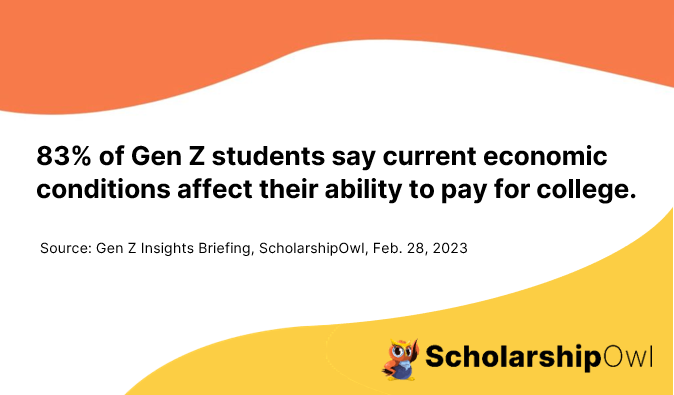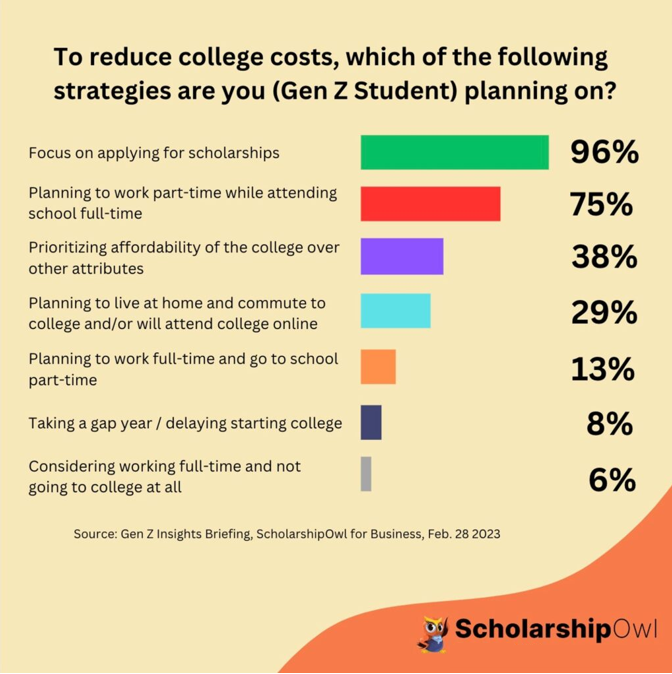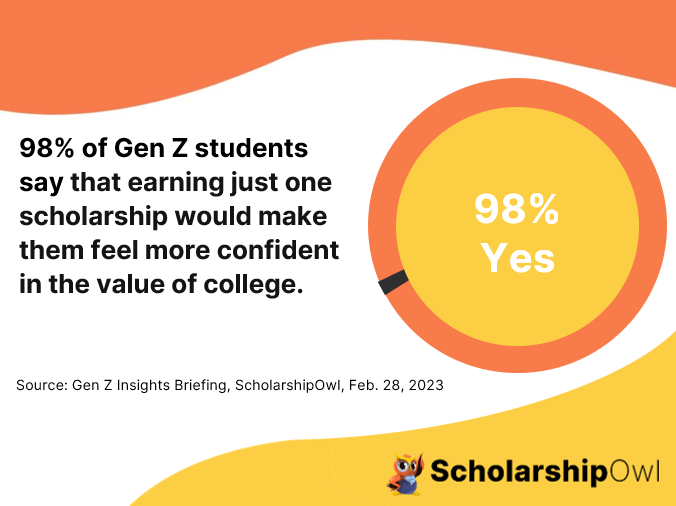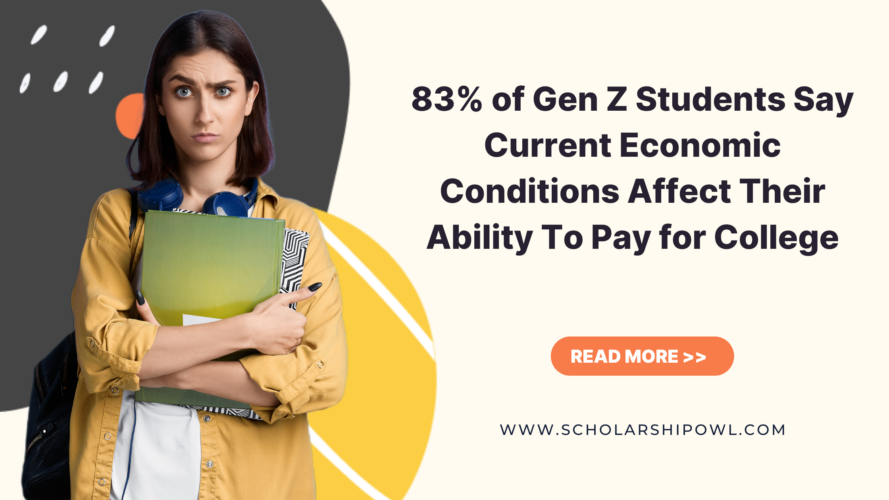Each month, ScholarshipOwl conducts a survey among students to develop a deep understanding of the key trends affecting Gen Z.
Given the current economic and inflationary conditions, in January 2023, we decided to focus on the impact of current economic conditions on students’ ability to afford the cost of college. This research is especially important given that some studies show that some students are questioning the value of college. In fact, a 2021 ECMC Group survey showed that less than half of high school students want to go to a four-year college, primarily due to financial concerns.
Who participated in the survey?
In January 2023, ScholarshipOwl surveyed over 9,000 high school and college-aged students on the ScholarshipOwl scholarship platform to find out the breadth and depth of the impact of economic conditions on today’s students. A total of 9,108 students responded to the survey. The respondents consisted of: 63% female, 36% male, and 1% who identified themselves as other. 55% identified themselves as high school students, with the vast majority high school seniors; 37% identified themselves as college undergraduate students, primarily college freshmen; 5% identified themselves as graduate students; and 3% identified themselves as adult/non-traditional students.
Survey questions
It was apparent that the economic and inflationary conditions in the new year had affected millions’ ability to afford basic goods, but how did these conditions affect student’s ability to afford the cost of college?
Win more scholarships with less effort
Simplify and focus your application process with the one-stop platform for vetted scholarships.
Check for scholarshipsThe first survey question was “Have current economic conditions affected your ability to pay for college?” The overwhelming majority (83%) responded “yes”, that the current economic conditions have affected their ability to pay for college, with just 17% indicating no impact.

As a follow-up question, we asked, “To reduce college costs, which of the following strategies are you planning on?” Students selected all responses that applied to them.
The vast majority of the respondents selected multiple strategies. Applying for scholarships and working part-time while attending school full-time were chosen most often. The full breakdown:
- 96% are focusing on applying for scholarships
- 75% plan to work part-time while attending school full-time
- 38% are prioritizing affordability of the college over other attributes (academics, reputation, location, etc.)
- 29% plan to live at home and commute to college and/or attend college online
- 13% plan to work full-time while attending college part-time
- 8% plan to take a gap year and/or delay starting college
- 6% are considering working full-time and not going to college at all

The final survey question asked was “If you could earn at least one scholarship, would you feel more confident in the value of college? Here, we found a bright spot to this survey, with 98% responding that earning just one scholarship would make them feel more confident in the value of college. This bellwether statement is a clear indicator that scholarships truly matter. Scholarships not only reduce the cost of college, but they also reward students for their effort and resiliency, boosting their confidence as they look ahead to their future beyond high school.

Key Takeaways for Gen Z students
The survey results clearly indicate that the current economic conditions are having a significant impact on students. In addition to economic conditions, students are also concerned about the rising cost of college in general. Together, this has resulted in students looking for a more affordable path to college. Some of the solutions students are choosing (working part-time or full-time, taking a gap year) may not only delay degree completion, but may also result in the student dropping out before completing, or not attending college at all.
These findings are coming at a time when the perceived value of college has declined, despite the fact that a recent report found that adults with a bachelor’s degree earn an average of $2.8 million during their careers, which is $1.2 million more than the median worker with a high school diploma. The report also indicated that for every additional level of education achieved, workers tend to earn more than those with less education.
And all of this is also happening during a critical time for employers, who are struggling to fill job openings with qualified candidates. Businesses have a vested interest in the school-to-work paradigm, ensuring a skilled and educated workforce is available to meet technology advances and production demands.
Brands can help Gen Z students forge a more affordable path to college
Despite the challenges faced, the good news is that the majority of students still hope to make their dream of a college education a reality. The survey indicates that students are looking at a variety of options to help fund their college education, but two solutions stand-out:
- 96% of students surveyed said that they are focusing on applying for scholarships to reduce their out-of-pocket cost.
- 83% of students plan to work either part-time or full-time while enrolled in college.
Brands Are Well-Positioned To Help Make These Solutions Happen:
- Through the ScholarshipOwl for Business platform, brands can create, launch and promote scholarship campaigns to Gen Z students to help reduce their cost of college.
- Brands can nurture their relationship with their scholarship applicants, sharing news and information about their products, as well as promoting internship and employment opportunities.
Brands Also Benefit By Being Part Of The Solution:
- When a brand launches and promotes a scholarship campaign, that brand is now “on the radar” of Gen Z. Students will develop positive feelings about the brand and its products, and be more interested in learning more.
- When students apply for a scholarship campaign, they are opting-in to a relationship with that brand. This presents an opportunity to connect with applicants, and then deepen that relationship over time.
- Students looking for internships and employment opportunities will naturally be more interested in working for companies that care about students. A scholarship campaign demonstrates the brand’s care and concern for students far better than an advertising campaign would, and does so for a much lower cost. A traditional advertising campaign makes students feel targeted rather than supported, and may be ineffective in reaching GenZ.
- Scholarship campaigns also can fulfill a business’ philanthropic efforts while supporting the company’s overarching mission and values.
To find out more about creating and launching a scholarship campaign that supports students while meeting business and philanthropic goals, visit business.scholarshipowl.com.



